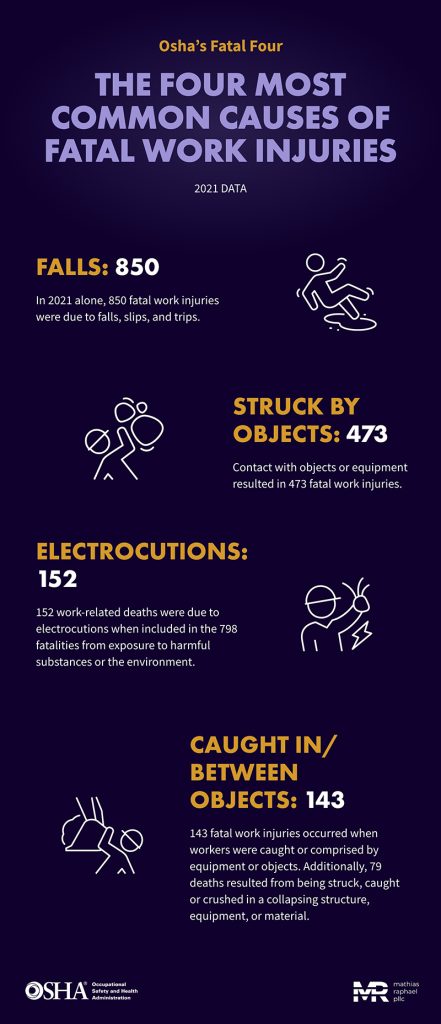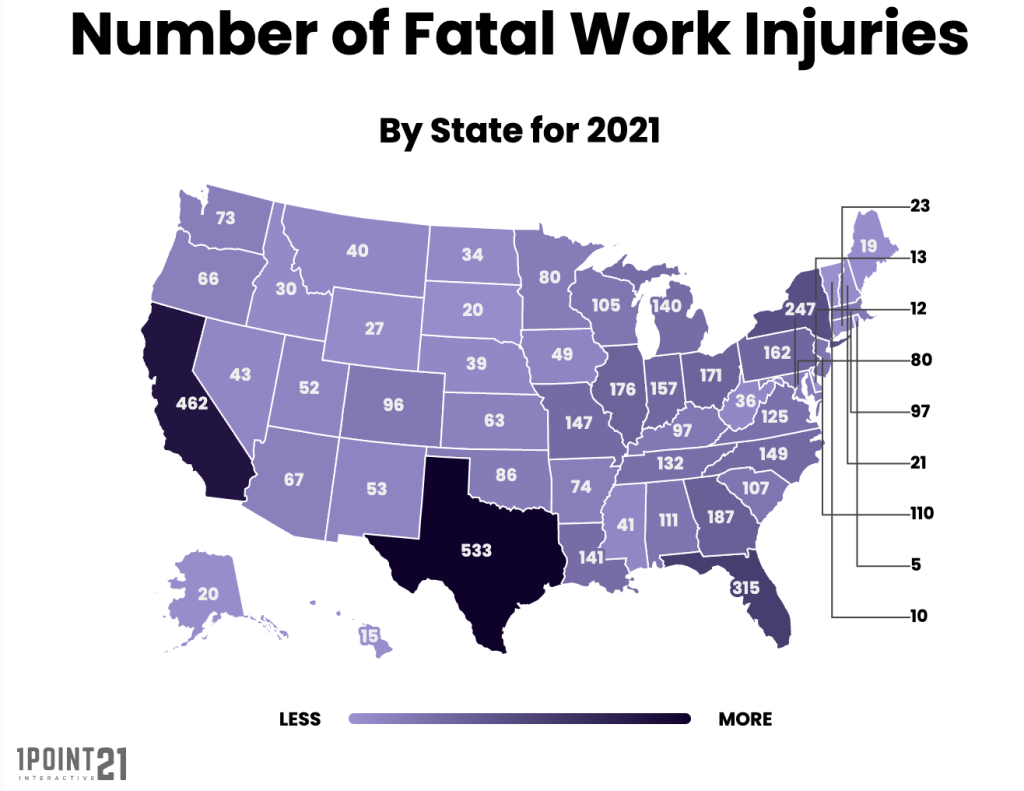Construction sites are considered to be one of the most hazardous workplaces, with a high risk of accidents and injuries. According to the Occupational Safety and Health Administration (OSHA), approximately 20% of all workplace fatalities occur in the construction industry. Additionally, construction workers are also at a higher risk of non-fatal injuries compared to other occupations. Mathias Raphael PLLC Accident & Injury Lawyers has compiled the following statistics that provide insights into recent data on work-related injuries in the United States construction industry, including both fatal and non-fatal incidents.
Most Common Causes of Construction Accidents (OSHAS Fatal Four)

According to OSHA’s “Fatal Four” list, the most common causes of construction accidents are falls, being struck by objects, electrocutions, and being caught in/between objects.
Falls: 850
Falls are the leading cause of construction-related fatalities, accounting for approximately one-third of all construction-related deaths.
Struck by Objects: 473
Being struck by objects, such as heavy machinery or falling debris, is the second most common cause of fatalities.
Electrocutions: 152
Electrocution deaths occur when a person is exposed to a lethal amount of electrical energy. Common causes of electrocution include contact with live wires or electrical appliances, lightning strikes, and power tool accidents.
Caught-in/between Objects: 143
These types of injuries occur when a worker is caught or crushed between two or more objects, such as heavy machinery or collapsing structures. Examples of caught-in/between object injuries include being caught in a trench cave-in or between a wall and a forklift.
Understanding these common causes can help employers and workers implement effective safety measures to prevent these accidents and ensure a safer workplace.
The Most Dangerous Jobs on Construction Sites
According to the National Safety Council, the construction industry has witnessed the highest number of fatalities since 2012, with the transportation and warehousing industry following closely. Falls are the primary cause of fatalities in the construction industry. Here are the top 10 occupations that resulted in fatal injuries in the construction industry for 2020:
- Construction laborers – 281
- First-line supervisors of construction trades and extraction workers – 134
- Roofers – 65
- Structural iron and steel workers – 16
- Construction equipment operators – 69
- Electricians – 61
- Carpenters – 45
- Construction managers – 47
- Heating, air conditioning, and refrigeration mechanics and installers – 18
- Plumbers, pipefitters, and steamfitters – 31
Number of Fatal Work Injuries by State

The data from the Bureau of Labor Statistics Census of Fatal Occupational Injuries State Fatal Work Injuries Map provides insight into fatal work injury rates across different states in the United States. The map shows that in 2021, the total number of fatal work injuries in the US was 5,188, a slight increase from the previous year. The states with the highest fatal work injury rates were Texas, California, and Florida. The majority of fatal work injuries occurred in the private industry sector, with construction being the industry with the highest number of fatalities and transportation and warehousing being the second industry of fatal work injuries for 2021. Within the private industry sector, the most frequent causes of fatalities were transportation incidents, followed by falls, slips, and trips. This data highlights the importance of workplace safety measures, to prevent fatal work injuries.
Race or Ethnic Origin of Construction Accidents [2020/2021]
2021 Fatal Work-related Injuries:
- White: 502
- Hispanic or Latino: 348
- Black or African American: 65
- American Indian or Alaska Native: 10
- Asian: 13
- Other races or not reported: 11
2020 Non-Fatal Work-related Injuries:
- White: 26,800
- Hispanic or Latino: 18,790
- Black or African American: 2,770
- American Indian or Alaska Native: 400
- Asian: 410
- Other races or not reported: 20,300
(*note: detailed nonfatal data is not currently available for 2021*)
The Breakdown of Construction Accident Injuries from 2011-2021
| Year | Fatal Injuries | Non-Fatal Injuries |
|---|---|---|
| 2021 | 951 | – |
| 2020 | 976 | 69,790 |
| 2019 | 1,066 | 77,560 |
| 2018 | 1,003 | 73,630 |
| 2017 | 965 | 74,560 |
| 2016 | 970 | 77,780 |
| 2015 | 924 | 72,070 |
| 2014 | 902 | 73,460 |
| 2013 | 845 | 77,380 |
| 2012 | 870 | 70,300 |
| 2011 | 798 | 74,580 |
The Risk Factors Relating to Construction Accidents
Training or Lack of
Construction workers who receive proper training on safety procedures and protocols are better equipped to identify and avoid potential hazards on the job site. Conversely, a lack of training can lead to workers not recognizing potential hazards, not knowing how to use equipment safely, and not understanding emergency protocols, all of which can increase the likelihood of accidents and injuries.
Fatigue
Construction work is physically demanding, and workers can become fatigued after extended periods of work. Fatigue can lead to slower reaction times, reduced cognitive abilities, and decreased attention to detail, which increases the risk of accidents and injuries. Workers who work extended hours or irregular schedules, and those who perform physically demanding tasks, are at a higher risk of experiencing fatigue.
Drug/Alcohol Use
Substance use, including drugs and alcohol, can significantly impair a worker’s ability to perform tasks safely. Workers who use drugs or alcohol are at a higher risk of being involved in an accident due to decreased motor skills, slower reaction times, impaired judgment, and reduced coordination.
Unsafe Conditions/Practices
Unsafe conditions and practices on a construction site can lead to accidents and injuries. This includes hazards such as inadequate safety equipment, poor lighting, unsecured materials, and uneven surfaces. Additionally, practices such as rushing to complete a task, cutting corners, or not following established safety protocols can also increase the risk of accidents and injuries.
Defective Equipment
Defective equipment, including tools and machinery, can also lead to accidents and injuries on construction sites. This can include equipment that is poorly maintained, outdated, or has design flaws. Equipment malfunctions can lead to worker injuries, and employers have a responsibility to ensure that their equipment is safe and properly maintained to prevent such incidents.
The Prevention of Construction Accidents
To maintain a safe construction site every construction company should implement safety training, drug/alcohol testing, safe work practices, and maintenance of equipment. Safety training ensures that workers are aware of potential hazards and know how to handle them. Another significant safety hazard is someone being under the influence while on the job. To ensure this does not happen, workers should be tested for both drugs and alcohol regularly. Wearing the correct personal protective equipment (PPE) will also minimize the risks of construction accidents or injuries. Likewise, inspection and maintenance of equipment will help establish that equipment is in good working form and does not pose a safety risk. In conclusion, implementing these practices and regulations can significantly reduce the risk of construction accidents and injuries. However, if you have been involved in a construction accident by no fault of your own, you need legal assistance from a Dallas construction accident lawyer at Mathias Raphael PLLC Accident & Injury Lawyers law firm. Safeguard your rights and get the justice you deserve.